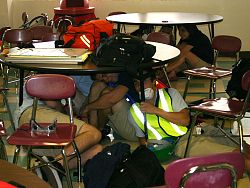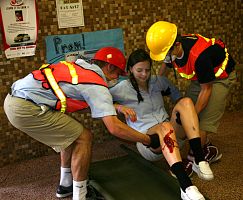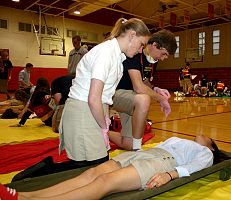Judge Memorial participates in Utah's Shakeout

SALT LAKE CITY —Judge Memorial Catholic High School activated its emergency plan for earthquake evacuation while participating in the statewide Great Utah ShakeOut earthquake drill April 17. At 10:15 a.m., George Angelo, Judge Memorial director of Sports Medicine, gave the announcement to "drop, cover and hold." "This drill has been part of a federal oversight to prepare the greater Salt Lake Valley for the effects of an earthquake, for which they say Utah is overdue," said Angelo. "We have been selected by the company Creative Letter 23 to produce a DVD for the State of Utah on the Teen C.E.R.T. program, which is the Teen Community Emergency Response Team. This program is nationwide; the federal government is trying to get teenagers involved in C.E.R.T. and search and rescue, and this DVD we are making will become a model for other communities in Utah and possibly the nation. Teen C.E.R.T. is something the federal government wants to see grow." The production of the DVD took place during the statewide ShakeOut event, which highlighted what the students have been doing in the junior and senior sports medicine classes directed by Angelo. Some of what the students have learned include: medical and first-aid, fire suppression, light search and rescue. "We train in first aid and CPR (cardiopulmonary resuscitation) at the beginning of the year and certify the students with the Red Cross," said Angelo. "In preparation for this DVD, we started training for the ShakeOut and how we could help the community and help each other." Judge Memorial senior Joshua Goldsmith was in charge of the medical triage for the ShakeOut. "We have been preparing for three months for this day," he said. "During triage, he was in charge of making sure everyone was set up correctly, had the supplies they needed and that all the teams were together. The teams included the medical, triage, search and rescue and victims." As the injured were brought into the triage center, Goldsmith assessed their injuries and told the medics whether their injuries were severe or mild. The victims were then placed in certain areas. The red area was for the most critical injuries; those people would need an ambulance and be the first ones taken to a hospital. The yellow area was for less severe injuries. "We’re worried about the people in the yellow area, but they can wait while we attend to the more critical patients," Goldsmith said. "The green area is for the walking wounded, who may just have a minor cut or a sprained ankle. The black area, which we didn’t have, would be for those who didn’t survive the earthquake." Each patient was given a number so the medics could keep track of them and they were listed on a whiteboard along with their injury, which area they were sent to and their vital signs.
© Copyright 2025 The Diocese of Salt Lake City. All rights reserved.



Stay Connected With Us